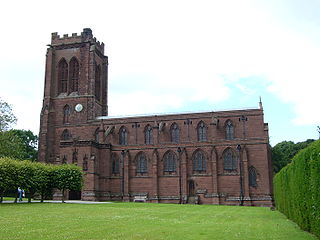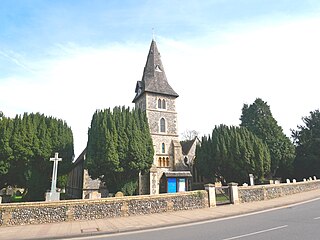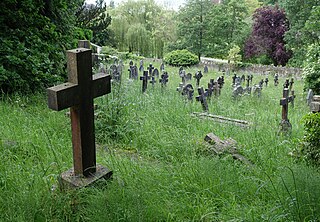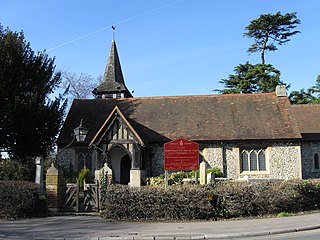
Bathwick is an area and electoral ward in the city of Bath, in the Bath and North East Somerset district, in the ceremonial county of Somerset, England, on the opposite bank of the River Avon to the historic city centre.

Barton Bendish is a civil parish and small ancient village in the English county of Norfolk located 10 miles (16 km) south of King's Lynn and 90 miles (140 km) North East of London. It has two medieval parish churches, and once had three. The parish includes the old hamlet of Eastmoor, and covers 3,936 acres (1,593 ha). The village has been settled since Neolithic times and was expanded during the Saxon period. Today the village has a population of 210 as recorded at the 2010 census and contains eight listed buildings, with the two medieval parishes churches being Grade I.

Beachamwell is a village and civil parish in the Breckland district of Norfolk, England about 5 miles (8.0 km) south west of Swaffham and 10 miles (16 km) east of Downham Market. It has four ancient churches, two of them in ruins. The former parish of Shingham has been annexed.
York had around 45 parish churches in 1300. Twenty survive, in whole or in part, a number surpassed in England only by Norwich, and 12 are used for worship. This article consists of a list of medieval churches which still exist in whole or in part, and a list of medieval churches which are known to have existed in the past but have been completely demolished.

Colchester in Essex, England, has a number of notable churches.
John Pinch was an architect working mainly in the city of Bath, England. He was surveyor to the Pulteney and Darlington estate and responsible for many of the later Georgian buildings in Bath, especially in Bathwick.

Grittleton is a village and civil parish in Wiltshire, England, 6 miles (10 km) northwest of Chippenham. The parish includes the hamlets of Foscote, Leigh Delamere, Littleton Drew and Sevington, and part of the hamlet of The Gibb.
Thomas Baldwin was an English architect in the city of Bath, who was responsible for designing some of Bath's principal Georgian buildings.

The Church of St Mary the Virgin is located on Darlington Street in the Bathwick area of Bath, Somerset, England. The church is Anglican and located near Pinch's Sydney Place (1808) and Bath's famed Sydney Pleasure Gardens. The church was constructed by the Pulteney family, who used it to replace the medieval parish church of St Mary's, Bathwick, known even in Georgian times as Bathwick Old Church. The churchyard is now part of Smallcombe Cemetery.

All Saints' Church is a Church of England parish church which stands on a hill at the centre of Weston, a small village on the outskirts of Bath, England. The current Gothic church was designed by architect John Pinch the Elder and completed in 1832, although it retains the 15th-century tower of its predecessor, All Hallows Church.

St Mary's Church is in the village of Eccleston, Cheshire, England, on the estate of the Duke of Westminster south of Chester. The church is recorded in the National Heritage List for England as a designated Grade I listed building. It is an active Anglican parish church in the diocese of Chester, the archdeaconry of Chester and the deanery of Chester. Its benefice is combined with that of St Mary, Pulford. The Dukes of Westminster are buried in the adjacent Old Churchyard.

St John the Baptist's Church is the former cathedral of Chester, Cheshire, England during the Early Middle Ages. The church, which was first founded in the late 7th Century by the Anglo Saxons, is outside Chester's city walls on a cliff above the north bank of the River Dee. It is now considered to be the best example of 11th–12th century church architecture in Cheshire, and was once the seat of the Bishop of Lichfield from 1075 to 1095.

The Church of St Mary the Virgin is in Leek Road, Bosley, Cheshire, England. It is recorded in the National Heritage List for England as a designated Grade II* listed building. It is an active Anglican parish church in the diocese of Chester, the archdeaconry of Macclesfield, and the deanery of Macclesfield. Its benefice is combined with those of St Michael, North Rode, St Michael, Wincle, and St Saviour, Wildboarclough.

St Laurence Pountney was a Church of England parish church in the Candlewick ward of the City of London. It was destroyed in the Great Fire of 1666, and not rebuilt.
John Pinch (1796–1849) was an architect, working mainly in the city of Bath, England, and surveyor to the Pulteney and Darlington estate. He was the son of John Pinch the elder, also an architect and surveyor to the estate.

St Mary the Virgin is a Gothic church in South London, built in the 12th century but with notable Gothic Revival modifications and additions in the mid-Victorian period to the designs of Sir George Gilbert Scott and his son John Oldrid Scott. It is dedicated to St Mary the Virgin. In its present form, this church is a hall church with an aisled nave of three vessels of similar heights under three parallel roofs

Smallcombe Cemetery is on the edge of Bath, Somerset, England, in a valley between Widcombe Hill and Bathwick Hill. It has two distinct parts, the Anglican section known as St Mary's Churchyard and the nonconformist section known as Smallcombe Vale cemetery; they are sometimes known together as Smallcombe Garden cemetery. The two cemeteries have been closed to new burials since 1988 and are maintained by Bath and North East Somerset Council. The Bath Corporation had assumed responsibility for both cemeteries in 1947.

St Mary the Virgin is the Church of England parish church for East Barnet within the Diocese of St Albans. It is located on Church Hill.

St Mary the Virgin is the parish church of Saffron Walden, Essex. It is the largest non-cathedral church in Essex with an overall length of 183 feet (56 m) and a spire 193 feet (59 m) high, which is the tallest in Essex. It was designated as a Grade I listed building in 1951.

St Mary the Virgin's Church, Chessington is a Grade II listed building, in Church Lane, Chessington, in the Royal Borough of Kingston upon Thames within Greater London. It is in the Diocese of Guildford. It became a separate parish from St. John the Baptist, Old Malden, in 1939.

















